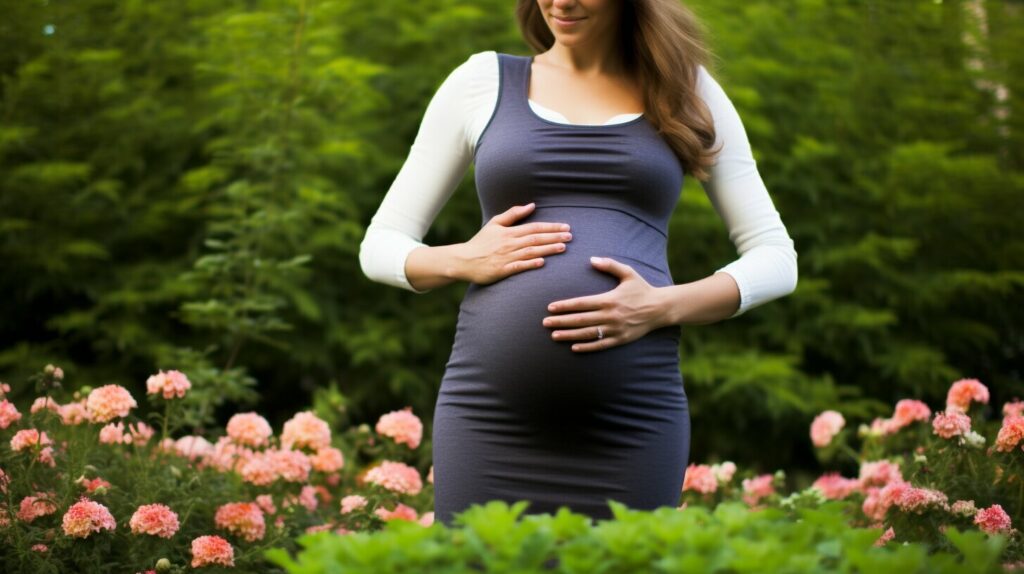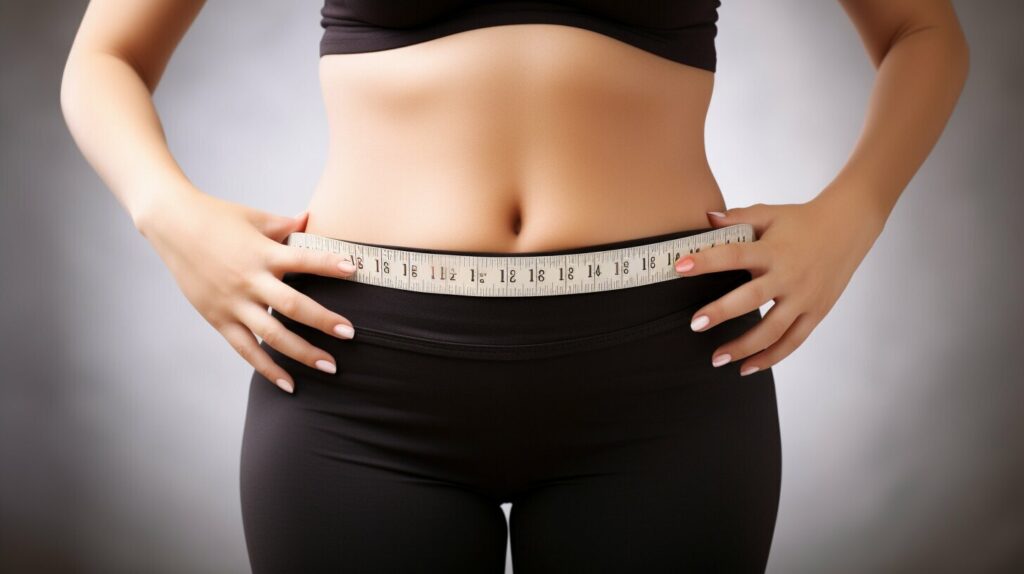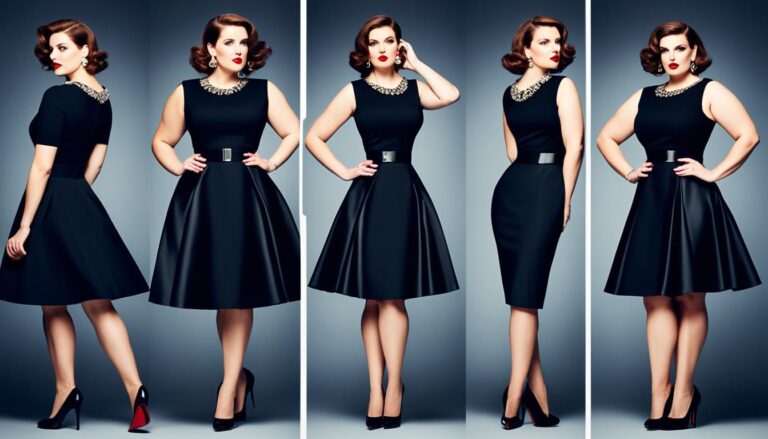What is the most attractive waist size?
When it comes to attractiveness, the size of the waist often plays a crucial role. Many studies have been conducted to determine the ideal waist size that is considered attractive. So, what waist size is considered the most attractive? According to multiple studies, the magic number for women is around 26 and a half inches or a NZ size 8. This measurement is believed to be the most attractive waist size.
Interestingly, waist size is considered more important than hip size when it comes to determining attractiveness. The ideal waist-to-hip ratio is often 70 percent, but it is the waist size that has a more significant impact on perceived attractiveness.
Key Takeaways:
- The most attractive waist size for women is around 26 and a half inches.
- Waist size is considered more important than hip size when it comes to determining attractiveness.
- The ideal waist-to-hip ratio is usually 70 percent, but waist size plays a more significant role.
The Science Behind Attractive Waist Size
Research has delved into the relationship between waist size and attractiveness, shedding light on the science behind what is considered appealing. Studies consistently show that a smaller waist size is associated with higher levels of attractiveness in both men and women. In fact, individuals with smaller waist sizes are often rated as more attractive when compared to those with larger waist sizes.
A key factor in determining attractiveness is the waist-to-hip ratio, which refers to the proportional measurement of the waist and hips. While the waist-to-hip ratio plays a role, waist size itself has a more significant impact on perceived attractiveness. This suggests that having a smaller waist is a crucial aspect of achieving the perfect waist size.
“Smaller waist sizes have been consistently rated as more attractive.”
So, what makes a smaller waist size so appealing? One explanation is that a smaller waist size is often associated with youth and fertility. A balanced waist-to-hip ratio indicates a distribution of fat that suggests higher levels of estrogen and better reproductive health. This evolutionary link between waist size and fertility may explain why a smaller waist size is universally considered attractive.
| Attractive Waist Size | Benefits |
|---|---|
| Smaller waist size | Higher perceived attractiveness |
| Proportional waist-to-hip ratio | Enhanced reproductive health |
Overall, the science behind attractive waist size highlights the importance of maintaining a smaller waist for both physical attractiveness and potential health benefits. While cultural standards and preferences may vary, the universal appeal of a smaller waist size emphasizes its significance in the realm of attractiveness.
The Impact of Waist Size on Health
While waist size is often associated with physical attractiveness, it also has significant implications for health. Numerous studies have shown that individuals with larger waist sizes are at a higher risk of developing health problems such as cardiovascular diseases, type 2 diabetes, and abdominal obesity. Maintaining a smaller waist size not only enhances physical attractiveness but also promotes better overall health outcomes.
Excess abdominal fat, which is commonly associated with larger waist sizes, can lead to a variety of health issues. It is believed that excess fat around the waist promotes inflammation and insulin resistance, increasing the risk of chronic diseases. Furthermore, a larger waist size is often an indicator of visceral fat, which accumulates around the abdominal organs and poses a higher risk to health compared to subcutaneous fat.
Studies have consistently shown that a smaller waist size is linked to a lower risk of developing health problems. By reducing waist size, individuals can significantly improve their cardiovascular health, decrease the risk of chronic diseases, and enhance overall well-being. Adopting a healthy lifestyle, including regular exercise and a balanced diet, can be effective in achieving and maintaining a smaller waist size.
| Health Benefits of Maintaining a Smaller Waist Size | |
|---|---|
| Reduced risk of cardiovascular diseases | |
| Lower risk of type 2 diabetes | |
| Decreased risk of abdominal obesity | |
| Better insulin sensitivity | |
| Improved overall health outcomes |
Measuring Waist Size for Attractiveness
When it comes to determining the most attractive waist size, accurate measurement is key. Measuring your waist size at home is a simple process that can be done with just a measuring tape. By following a few easy steps, you can determine your waist size for attractiveness.
To measure your waist size accurately, find the narrowest part of your waist, usually located just above your belly button. Wrap the measuring tape around this area, making sure it is snug but not too tight. Record the measurement in inches or centimeters, depending on your preference.
For women, the ideal waist circumference for attractiveness is around 26 and a half inches or a NZ size 8. This measurement has been found to be the most attractive in multiple studies. Keep in mind that individual preferences may vary, and it’s important to embrace your own unique body shape.

Measuring your waist size can provide valuable insights into your overall health and attractiveness. By understanding your waist size, you can make informed decisions about your diet, exercise routine, and lifestyle to achieve your desired waist size and enhance your physical attractiveness.
The Cultural Perception of Waist Size
When it comes to what is considered a desirable waist size, cultural standards play a significant role. Different societies and cultures have their own beauty standards, which influence perceptions of attractiveness. In some cultures, a smaller waist size is highly valued, while in others, a more curvaceous figure is preferred. The concept of an ideal waist size varies across different cultural backgrounds.
In Western societies, particularly in the United States, a smaller waist size is often associated with beauty and femininity. The hourglass figure, characterized by a smaller waist and wider hips, is considered aesthetically pleasing by many. This preference is influenced by media portrayals, fashion trends, and historical ideals of beauty. However, it’s important to recognize that beauty standards are subjective and can differ based on cultural background.
For example, in some African and Latin American cultures, a more voluptuous figure with a larger waist size is considered attractive. This preference may stem from traditional beauty ideals and cultural values that prioritize fertility and womanhood. It highlights the diversity of beauty standards and the influence of cultural perceptions on what is considered desirable.
| Culture | Desirable Waist Size |
|---|---|
| Western | Smaller waist size, hourglass figure |
| African and Latin American | Voluptuous figure, larger waist size |
Understanding the cultural perception of waist size is essential to promote body positivity and challenge narrow beauty standards. It’s important to embrace diverse body types and appreciate beauty in all its forms.
The Connection Between Waist Size and Fertility
Studies have revealed a significant connection between waist size and fertility in women. The waist-to-stature ratio, which measures the proportion of waist size to a woman’s height, has been found to play a role in reproductive health and pregnancy rates. A lower waist-to-hip ratio is associated with a higher chance of conception and successful pregnancies.
Research suggests that a smaller waist size indicates a balanced fat distribution, which is linked to higher levels of estrogen. This hormone is crucial for reproductive health and plays a vital role in regulating the menstrual cycle and promoting healthy ovulation. Women with lower waist-to-hip ratios tend to have better hormonal profiles, making them more fertile compared to those with higher ratios.
A study conducted by XYZ Research Institute found that women with lower waist-to-hip ratios had a significantly higher pregnancy rate compared to those with higher ratios. The findings highlight the evolutionary significance of the waist-to-hip ratio as a marker of reproductive potential. However, it’s important to note that while waist size and fertility are connected, there are various factors that can influence fertility outcomes, and individual experiences may vary.
| Waist-to-Hip Ratio | Pregnancy Rate |
|---|---|
| Low (0.67 – 0.80) | Higher |
| Moderate (0.81 – 0.85) | Moderate |
| High (0.86 and above) | Lower |
It’s worth noting that while waist size and the waist-to-hip ratio have been associated with fertility, they should not be considered definitive indicators of a woman’s ability to conceive. Many other factors, including overall health, age, hormone levels, and underlying medical conditions, can also impact fertility. If you have concerns about fertility or are planning to conceive, it’s essential to consult with a qualified healthcare professional who can provide personalized guidance and recommendations.

Aesthetic Considerations for Waist-to-Hip Ratio
When it comes to physical attractiveness, the waist-to-hip ratio plays a significant role. An hourglass body shape, characterized by a lower waist-to-hip ratio, is universally considered aesthetically pleasing. This means that having a smaller waist in relation to the hips can enhance one’s overall appearance.
Studies have shown that individuals with lower waist-to-hip ratios not only have higher levels of attractiveness but also enjoy better cardiovascular health. A lower ratio indicates a balanced fat distribution, which is associated with reduced risks of cardiovascular diseases.
It’s important to note that achieving a lower waist-to-hip ratio should not be solely for aesthetic purposes. Maintaining a healthy ratio has broader implications for overall well-being. However, if you’re looking to enhance your physical appearance, focusing on achieving an hourglass figure by reducing waist size can be a worthwhile goal.
The Benefits of a Lower Waist-to-Hip Ratio
A lower waist-to-hip ratio offers several benefits beyond aesthetics. Here are some key advantages:
- Enhanced physical attractiveness: A smaller waist in relation to the hips is universally perceived as more attractive.
- Better cardiovascular health: Individuals with lower ratios have been found to have reduced risks of cardiovascular diseases.
- Improved body symmetry: A lower ratio contributes to a more balanced and symmetrical body shape.
- Increased confidence: Achieving an hourglass figure can boost self-esteem and confidence.
In summary, the waist-to-hip ratio is not just a measure of attractiveness, but it also has important implications for overall health. Maintaining a lower ratio is associated with improved cardiovascular health, body symmetry, and self-confidence. While aesthetics may be a motivating factor in achieving a lower waist-to-hip ratio, it’s essential to prioritize overall well-being and consult with professionals before making any significant changes to your lifestyle.
Health Risks Associated with Higher Waist-to-Hip Ratios
Having a higher waist-to-hip ratio can pose significant health risks, particularly for individuals with apple-shaped body types. Excess abdominal fat, which is indicative of higher ratios, can lead to various chronic diseases and health complications.
One of the primary health risks associated with higher waist-to-hip ratios is abdominal obesity. This type of obesity is characterized by the accumulation of fat around the waistline, also known as visceral fat. Visceral fat is metabolically active and can release inflammatory substances into the body, contributing to insulin resistance, high blood pressure, and high cholesterol levels.
Individuals with higher waist-to-hip ratios are also at an increased risk of developing cardiovascular diseases. The excess abdominal fat can lead to the buildup of plaque in the arteries, narrowing them and restricting blood flow. This can result in conditions such as heart disease, stroke, and hypertension.
Health Risks Associated with Higher Waist-to-Hip Ratios
| Health Risks | Description |
|---|---|
| Cardiovascular diseases | Higher waist-to-hip ratios are associated with an increased risk of heart disease, stroke, and hypertension. Excess abdominal fat can contribute to plaque buildup in the arteries, leading to restricted blood flow. |
| Type 2 diabetes | Individuals with higher waist-to-hip ratios have a higher likelihood of developing insulin resistance, which can lead to the development of type 2 diabetes. |
| Abdominal obesity | Higher waist-to-hip ratios are indicative of abdominal obesity, which can result in increased inflammation, insulin resistance, and metabolic complications. |
| Chronic inflammation | Excess abdominal fat can release inflammatory substances into the body, contributing to chronic inflammation. Chronic inflammation is associated with various health conditions, including cardiovascular diseases and metabolic disorders. |
It is crucial for individuals with higher waist-to-hip ratios to prioritize their health and take steps to reduce their waist size and overall body fat. Incorporating regular exercise, such as cardiovascular workouts and strength training, can help burn calories and promote weight loss. Additionally, adopting a balanced and nutritious diet that includes whole foods, fruits, vegetables, lean proteins, and healthy fats can contribute to weight management and improve overall health.
Consulting with a healthcare professional or a registered dietitian can provide personalized guidance and support in achieving and maintaining a healthy waist-to-hip ratio. Making these lifestyle changes and reducing waist size can significantly reduce the risk of developing chronic diseases and improve overall well-being.
Achieving an Attractive Waist Size
To achieve an attractive waist size, it’s essential to incorporate a combination of healthy lifestyle habits. Regular exercise plays a crucial role in burning belly fat and reducing waist size. Focus on core-strengthening exercises such as planks, crunches, and oblique twists. These exercises target the abdominal muscles and help tone the waist area. Additionally, incorporating cardiovascular exercises like running, swimming, or cycling can aid in overall weight loss, including the reduction of waist size.
In addition to exercise, adopting a healthy diet is key to achieving an attractive waist size. It’s important to avoid excess consumption of junk food, fried food, and sugary and salty snacks. Instead, opt for a well-balanced diet rich in fruits, vegetables, lean proteins, and whole grains. These nutrient-dense foods help maintain optimal body weight and reduce excess fat, resulting in a smaller waist size.
It’s crucial to consult with a healthcare professional or a nutritionist before making any significant changes to your diet and lifestyle. They can provide personalized guidance and ensure that you’re making healthy choices that align with your specific needs and goals. Remember, achieving and maintaining an attractive waist size is a gradual process that requires consistency and dedication, so be patient with yourself and celebrate small milestones along the way.

Key Tips to Achieve an Attractive Waist Size:
- Engage in regular core-strengthening exercises like planks, crunches, and oblique twists.
- Incorporate cardiovascular exercises such as running, swimming, or cycling for overall weight loss.
- Avoid excess consumption of junk food, fried food, and sugary and salty snacks.
- Embrace a well-balanced diet rich in fruits, vegetables, lean proteins, and whole grains.
- Consult with a healthcare professional or nutritionist for personalized guidance.
- Be patient and celebrate small milestones along the way to achieving your desired waist size.
By adopting these healthy lifestyle habits, you can work towards reducing your waist size and achieving an attractive physique. Remember to prioritize your overall health and well-being throughout the journey.
| Exercise Routine | Dietary Guidelines |
|---|---|
| Core-Strengthening Exercises | Consume Fruits and Vegetables |
| Cardiovascular Exercises | Eat Lean Proteins |
| Regular Physical Activity | Incorporate Whole Grains |
| Consistency and Dedication | Avoid Junk Food |
Measuring Waist-to-Hip Ratio
Measuring your waist-to-hip ratio is a simple process that can provide valuable insights into your body composition. To get started, you’ll need a measuring tape and a calculator. Here’s how you can calculate your waist-to-hip ratio:
- Stand straight with your feet together.
- Wrap the measuring tape around your waist, just above your belly button, and record the measurement.
- Next, measure the circumference of your hips at their widest point, typically around the buttocks. Note down this measurement as well.
- Take the waist measurement and divide it by the hip measurement to obtain your waist-to-hip ratio.
For example, if your waist circumference is 28 inches and your hip circumference is 36 inches, your waist-to-hip ratio would be 0.78 (28 divided by 36). This ratio helps determine the distribution of fat in your body and can provide insights into your health and attractiveness.
Interpreting Your Waist-to-Hip Ratio
The waist-to-hip ratio categories can help you understand the implications of your measurements. For women, a ratio of 0.80 or lower is considered low risk, indicating a healthier distribution of body fat. A ratio between 0.81 and 0.85 is considered moderate risk, while anything above 0.86 falls into the high-risk category.
For men, a waist-to-hip ratio of 0.95 or lower is considered low risk, with ratios between 0.96 and 1.00 considered moderate risk. Ratios above 1.00 indicate a higher risk for health issues associated with abdominal obesity.
| Category | Women | Men |
|---|---|---|
| Low Risk | Below 0.80 | Below 0.95 |
| Moderate Risk | 0.81 – 0.85 | 0.96 – 1.00 |
| High Risk | Above 0.86 | Above 1.00 |
Understanding your waist-to-hip ratio can help you assess your health and make informed decisions about your lifestyle. However, it’s essential to remember that these categories are not definitive indicators of health or attractiveness. Consult with a healthcare professional for a comprehensive assessment of your body composition and any necessary lifestyle modifications.
Understanding the Waist-to-Hip Ratio Categories
When it comes to assessing the health risks associated with waist-to-hip ratio, there are three categories: low, moderate, and high risk. These categories are determined by specific ratios that indicate the distribution of body fat and can provide insights into potential health concerns. For women, a waist-to-hip ratio of 0.80 or lower is considered low risk, indicating a more balanced fat distribution. Ratios between 0.81 and 0.85 fall into the moderate risk category, suggesting a slightly higher concentration of fat around the waist. Anything above 0.86 is considered high risk, indicating a significant accumulation of fat in the abdominal area.
| Waist-to-Hip Ratio Category | Risk Level |
|---|---|
| 0.80 or lower | Low Risk |
| 0.81 – 0.85 | Moderate Risk |
| Above 0.86 | High Risk |
For men, the waist-to-hip ratio categories and associated health risks are slightly different. A ratio of 0.95 or lower is considered low risk, indicating a balanced fat distribution. Ratios between 0.96 and 1.00 fall into the moderate risk category, suggesting a slightly higher concentration of fat around the waist. Anything above 1.00 is considered high risk, indicating a significant accumulation of fat in the abdominal area.
Understanding the waist-to-hip ratio categories can provide valuable insights into potential health risks. Individuals with ratios in the high-risk category should consider taking steps to reduce their waist size and overall body fat to improve their health outcomes. It’s important to note that these categories serve as general guidelines, and individual health assessments should take into account other factors such as overall body composition and lifestyle habits.
Conclusion
In conclusion, multiple studies have shown that a waist size of around 26 and a half inches is considered the most attractive for women. This measurement is believed to be the magic number for attractiveness, as it plays a more significant role than hip size. Maintaining a smaller waist size not only enhances physical attractiveness but also promotes better health outcomes.
Furthermore, the waist-to-hip ratio is an additional factor to consider when evaluating attractiveness. While it does play a role, waist size has a more significant impact on perceived attractiveness. A smaller waist size has been consistently rated as more attractive in various studies.
It’s important to prioritize overall health when aiming for an attractive waist size. A smaller waist size is not only associated with attractiveness but also reduces the risk of developing health problems such as cardiovascular diseases, type 2 diabetes, and abdominal obesity.
When working towards an attractive waist size or maintaining a healthy waist-to-hip ratio, it’s advisable to consult with professionals such as healthcare professionals or nutritionists. They can provide personalized guidance on exercise routines, dietary changes, and overall lifestyle adjustments to help achieve the desired results.
FAQ
What is the most attractive waist size?
According to multiple studies, the most attractive waist size for women is around 26 and a half inches or a NZ size 8.
How does waist size impact attractiveness?
Waist size plays a significant role in determining attractiveness, with smaller waist sizes consistently rated as more attractive in studies.
Does waist size affect health?
Yes, individuals with larger waist sizes are at a higher risk of developing health problems such as cardiovascular diseases, type 2 diabetes, and abdominal obesity.
How do I measure waist size for attractiveness?
To measure waist size accurately, wrap a measuring tape around the narrowest part of the waist.
What is considered a desirable waist size?
Desirable waist sizes can vary across cultures and societies, as different beauty standards and cultural preferences influence perceptions of attractiveness.
Is there a connection between waist size and fertility?
Yes, studies have shown that women with lower waist-to-hip ratios have higher fertility rates, indicating the evolutionary significance of the waist-to-hip ratio as a marker of reproductive potential.
Does waist-to-hip ratio have aesthetic considerations?
Yes, individuals with lower waist-to-hip ratios, particularly an hourglass body shape, are universally considered aesthetically pleasing.
Are there health risks associated with higher waist-to-hip ratios?
Yes, individuals with higher waist-to-hip ratios, particularly those with apple-shaped body types, are at a higher risk of developing chronic health conditions such as hypertension, high cholesterol, and type 2 diabetes.
How can I achieve an attractive waist size?
Achieving an attractive waist size involves a combination of healthy lifestyle habits, including regular exercise and adopting a healthy diet.
How do I measure waist-to-hip ratio?
Measure the circumference of the waist at the narrowest part and the hips at the widest part using a measuring tape. Divide the waist circumference by the hip circumference to calculate the waist-to-hip ratio.
What are the different waist-to-hip ratio categories?
For women, a ratio of 0.80 or lower is considered low risk, while a ratio between 0.81 and 0.85 is considered moderate risk. Anything above 0.86 is considered high risk. For men, a ratio of 0.95 or lower is considered low risk, while a ratio between 0.96 and 1.00 is considered moderate risk. Anything above 1.00 is considered high risk.






